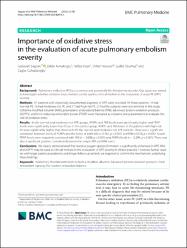Importance of oxidative stress in the evaluation of acute pulmonary embolism severity

View/
Access
info:eu-repo/semantics/openAccessDate
2022Author
Sağcan, GülserenKonukoğlu, Dildar
Uzun, Hafize
Arseven, Orhan
Okumuş, Gülfer
Çuhadaroğlu, Çağlar
Metadata
Show full item recordCitation
Sagcan, G., Konukoglu, D., Uzun, H., Arseven, O., Okumus, G., & Cuhadaroglu, C. (2022). Importance of oxidative stress in the evaluation of acute pulmonary embolism severity. BMC Pulmonary Medicine, 22(1). pp. 382-389, https://doi.org/10.1186/s12890-022-02076-x Abstract
Background: Pulmonary embolism (PE) is a common and potentially life-threatening disorder. Our study was aimed
to investigate whether oxidative stress markers can be used as clinical markers in the evaluation of acute PE (APE)
severity.
Methods: 47 patients with objectively documented diagnosis of APE were recorded. Of these patients, 14 had
low-risk PE, 16 had moderate-risk PE, and 17 had high-risk PE. 21 healthy subjects were also enrolled in this study.
Ischemia-modifed albumin (IMA), prooxidants-antioxidants balance (PAB), advanced protein oxidation products
(AOPPs), and ferric reducing antioxidant power (FRAP) were measured as oxidative stress parameters to evaluate the
role of oxidative stress.
Results: In the low-risk and moderate-risk APE groups, AOPPs and PAB levels were signifcantly higher and FRAP
levels were signifcantly lower than those in the control group. AOPPs and IMA levels in the patients with high-risk
PE were signifcantly higher than those in both the low-risk and moderate-risk APE patients. There was a signifcant
correlation between levels of AOPPs and the levels of both IMA (r: 0.462, p<0.001) and PAB (r:0.378, p<0.005). Serum
FRAP levels were negatively correlated with PAB (r:− 0.683, p<0.001) and AOPPs levels (r:− 0,384, p<0.001). There was
also a signifcant positive correlation between the serum IMA and PAB levels.
Conclusions: We clearly demonstrated that reactive oxygen species formation is signifcantly enhanced in APE. IMA
and AOPPs may be used as clinical markers in the evaluation of APE severity in clinical practice. However, further stud ies with larger patient populations and longer follow-up periods are required to confrm the mechanisms underlying
these fndings.
















